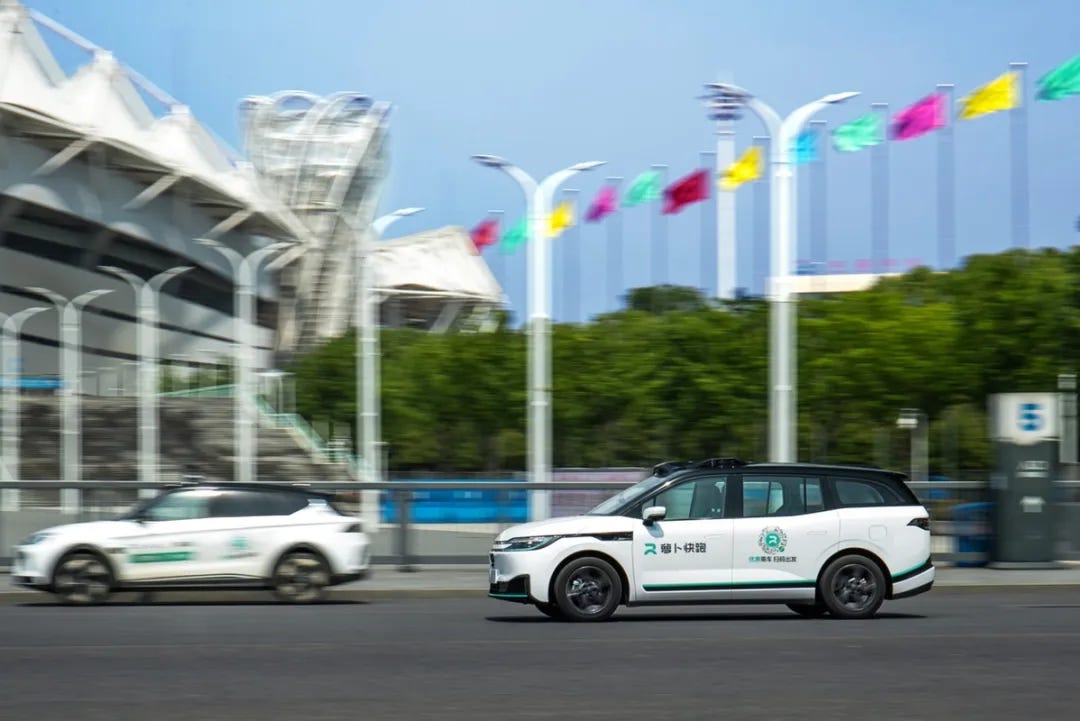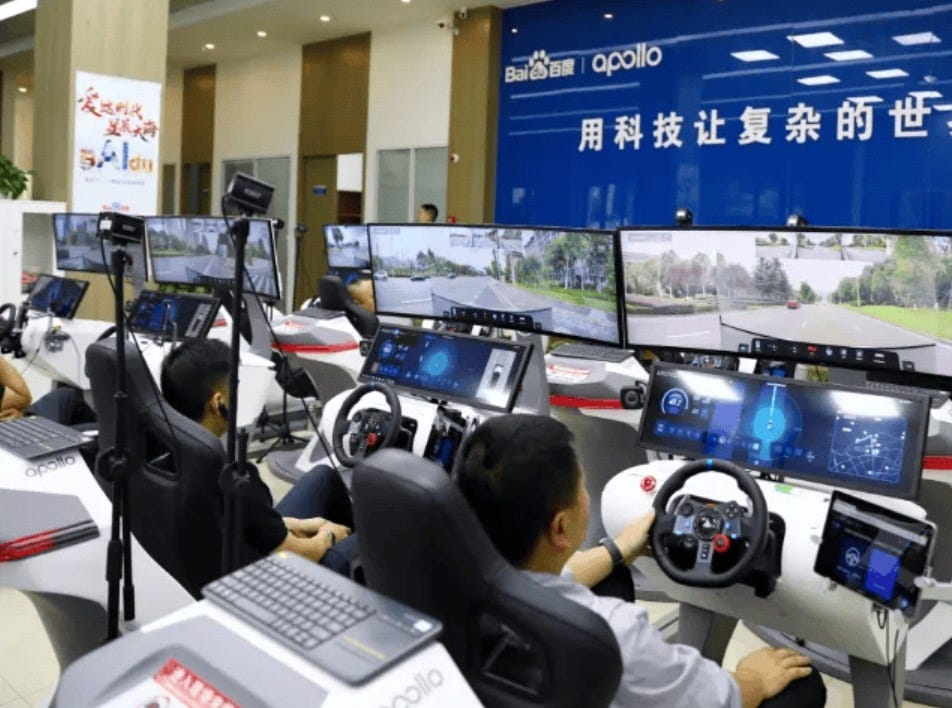The World's Largest Robotaxi Operation that You Don't Know | reinvent the wheel #1
And its name is not Waymo or Tesla.
Baidu’s robotaxi operation in Wuhan might just be the most ambitious autonomous driving project you’ve never heard of. While Tesla and Waymo dominate global headlines, Baidu quietly runs a fleet of over 300 robotaxis in Wuhan, with plans to scale to 1,000 by year-end. It’s a vision of China’s tech prowess in action, transforming a city once known for manufacturing combustion engines into a testing ground for intelligent transportation. This isn’t just about rides—it’s a fusion of AI innovation, urban reinvention, and national pride, all wrapped up in a robotaxi that might one day replace your human driver.
1. Background:China's Automotive Ambitions and a City's Reinvention
Baidu operates a substantial robotaxi fleet in Wuhan. One source places the total number of robotaxis deployed in Wuhan at over 300 as of June 2024, with ambitions to increase this figure to over 1,000 by the end of the year.
Baidu's Apollo Go robotaxi project isn't just another tech venture; it's a carefully calculated move by China's tech giant to be at the forefront of the global autonomous vehicle revolution. The strategic choice of Wuhan as its primary testing ground goes beyond mere coincidence; it reveals a symbiotic relationship between Baidu's aspirations and the city's ambition to reinvent itself as a global leader in intelligent transportation.
Wuhan, once a powerhouse of traditional car manufacturing, missed the initial wave of the electric vehicle boom. Now, the city is determined to not be left behind in the next phase of automotive evolution – intelligent vehicles. Boasting the world's most extensive autonomous driving test mileage, Wuhan has aggressively courted companies like Baidu, offering a favorable regulatory environment and the infrastructure needed for large-scale robotaxi deployment. For Baidu, this presents a golden opportunity to not just test and refine its technology but also shape the narrative around autonomous vehicles in China and beyond.
Internationally, Tesla, with its advanced driver-assistance systems and ambitions for a global robotaxi network, looms large. Waymo, backed by the immense resources of Google, has already established a significant lead in cities like Phoenix and San Francisco.
2. Worries from Drivers: Technological Advancement and the Specter of Job Displacement
The rapid deployment of robotaxis in Wuhan has cast a long shadow over the city's taxi and ride-hailing drivers, fueling anxieties about job security in an already precarious economic climate. These concerns are far from unfounded. The emergence of ride-hailing platforms like Didi Chuxing had already saturated the market, leading to dwindling incomes and fierce competition among drivers. The introduction of robotaxis, perceived as a direct threat to their livelihoods, has intensified these anxieties, leading to public outcry and even calls for limiting their deployment.
The situation in Wuhan mirrors a broader global debate about the impact of AI and automation on employment. While proponents of these technologies argue that they will create new jobs and enhance productivity, critics point to the potential for mass displacement, particularly in sectors like transportation, where automation is rapidly advancing. This debate is further complicated by the lack of clear solutions or safety nets for workers whose jobs are at risk, raising concerns about social unrest and inequality.
The Chinese government faces a delicate balancing act. On the one hand, it seeks to position China as a leader in AI and autonomous vehicles, a strategic priority for economic growth and national pride. On the other hand, it must grapple with the potential social consequences of rapid technological change, particularly the risk of exacerbating unemployment in a country already grappling with a shrinking workforce.
3. Technology: From Human Oversight to Full Autonomy
Baidu Apollo's robotaxi fleet in Wuhan relies on a complex interplay of cutting-edge technologies, with a keen focus on balancing performance with cost-effectiveness. Initially, the company relied heavily on the BAIC Arcfox Alpha, a reliable but relatively expensive electric vehicle. To achieve profitability, Baidu has shifted its focus to the JAC RT6, a more economical model specifically designed for autonomous ride-hailing. This transition highlights the crucial role of cost optimization in making robotaxi services commercially viable.
Baidu's sixth-generation autonomous vehicle, RT6, has begun large-scale fully driverless road testing.
While Baidu's promotional materials often emphasize the autonomous nature of its robotaxis, the reality on the ground reveals a continued reliance on human oversight. A dedicated team of safety operators, stationed in a centralized 'cloud control' center, monitors the vehicles in real-time, ready to intervene remotely if the AI encounters difficulties or unexpected situations. This behind-the-scenes human intervention underscores the challenges of achieving full autonomy in complex urban environments.
There is speculation that, in certain circumstances, the vehicle may be driven remotely by a person.
Baidu is pinning its hopes on its sixth-generation robotaxi to bridge this gap. Currently under development, this new model aims to achieve complete driverlessness, eliminating the need for safety operators and significantly reducing operating costs. This technological leap, if successful, could be a game-changer for the robotaxi industry, potentially paving the way for widespread adoption and profitability.
4. Business Model and Operation: A Delicate Balancing Act Between Growth and Sustainability
Baidu's robotaxi operation in Wuhan is characterized by a high level of human involvement, particularly in areas like road testing, remote operation, and on-site support. The company employs a sizable workforce of approximately 600 individuals, with roles ranging from road testers who meticulously map routes and identify potential hazards to 'cloud control' operators who monitor vehicles and provide remote assistance. This labor-intensive approach, while ensuring safety and a smooth user experience, presents a significant challenge to profitability.
Recognizing the need for greater efficiency, Baidu is actively exploring ways to optimize its operational model. The company is increasingly leveraging strategic partnerships to outsource non-core functions. For instance, Baidu has partnered with Tuhu, a leading automotive aftermarket service provider, to handle vehicle maintenance, streamlining operations and potentially reducing costs. Additionally, Baidu is considering collaborating with established ride-hailing platforms like Didi Chuxing to handle on-site support, further reducing its reliance on a dedicated fleet management team.
Another key aspect of Baidu's strategy is its aggressive pricing model. The company heavily subsidizes rides, offering free first-time trips and generous discounts to attract customers and drive market adoption. While this approach has contributed to a surge in ridership, with some vehicles completing over 20 trips per day, it raises questions about long-term sustainability. Achieving profitability will require striking a delicate balance between maintaining attractive prices for users and reducing operational costs.
Baidu remains optimistic about achieving profitability by 2025, though the actual financial performance of its robotaxi venture remains shrouded in secrecy. The company's reluctance to disclose detailed financial data makes it difficult to assess the true cost of operation and the timeline for achieving a sustainable business model.
5. Strategic Significance for Baidu: Beyond Profit - National Pride and Technological Supremacy
Baidu's robotaxi initiative transcends a simple business venture; it represents a strategic imperative with profound implications for the company's future and China's place in the global technological order. Success in this arena would be a potent symbol of China's growing technological prowess, challenging the dominance of western companies like Tesla and Waymo.
For Baidu, a company whose core advertising revenue has stagnated in recent years, the success of its robotaxi venture is crucial for securing its future. It presents an opportunity to leverage its existing strengths in AI, mapping, and navigation to establish a foothold in a potentially lucrative and rapidly growing market. The implications extend far beyond financial gain. By becoming a dominant player in autonomous vehicles, Baidu can position itself at the forefront of a technological revolution, transforming its image from a primarily search engine company to a global leader in intelligent transportation.
The Chinese government's enthusiastic support for autonomous vehicle development, exemplified by its designation of Wuhan as a pilot city for 'vehicle-road-cloud integration,' underscores the strategic importance of this technology. It aligns with China's broader ambition to become a global leader in AI and intelligent systems, a key component of its 'new quality productivity' economic model.
6. Regulation and the Legal Landscape: Navigating Uncharted Territory
Baidu Apollo operates within a complex and rapidly evolving regulatory landscape in China. The Chinese government, eager to foster innovation and establish itself as a leader in the autonomous vehicle industry, has adopted a generally supportive stance, enacting policies to streamline testing and deployment. However, navigating this regulatory maze remains a significant challenge for companies like Baidu.
Obtaining permits to operate in specific areas, particularly those with high traffic density, often involves a lengthy and opaque process, subject to the discretion of local authorities. For instance, securing permission for Apollo Go to operate on major highways or near transportation hubs in Wuhan required significant coordination with various government agencies.
The question of liability in case of accidents involving robotaxis represents a major legal challenge. While Baidu asserts that its vehicles have a significantly lower accident rate than human drivers and that all passengers are covered by comprehensive insurance, public concerns persist. Existing regulations generally hold the operating company liable if the autonomous system is deemed at fault. However, determining fault in complex traffic scenarios involving autonomous vehicles raises intricate legal questions about the role of AI, human oversight, and the interplay of various systems.
Recognizing the need for greater clarity and consistency, the Chinese government is actively developing a comprehensive legal framework for autonomous vehicles. The draft regulations recently proposed in Beijing, which explicitly address issues like licensing, liability, data privacy, and the ethical implications of autonomous driving, signal a significant step towards establishing national-level guidelines. This evolving legal landscape adds another layer of complexity to Baidu's robotaxi venture, requiring constant adaptation and highlighting the importance of close collaboration with regulators.
7. A Long Road Ahead
Baidu's Apollo Go robotaxi project in Wuhan is a microcosm of the challenges and opportunities presented by autonomous vehicle technology. It's a testament to China's technological ambitions and its determination to be a dominant player in shaping the future of transportation. However, the road to widespread adoption is paved with complexities. Balancing rapid technological advancement with addressing valid concerns about job security, navigating an evolving regulatory environment, and ensuring public trust will be crucial for Baidu's success.
It will be tricker than dealing with a plastic bag in the middle of the road.





